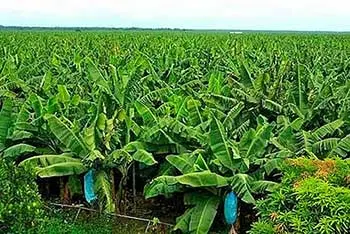Mataasnakahoy: Recovering from the Abaca Decline in the 1920s
[In this article: Mataasnakahoy Batangas, Kasaysayan ng Mataasnakahoy, Mataasnakahoy history, Ceferino Capuchino, Templo family, Silva family, original settlers Mataasnakahoy, immigrants to Mataasnakahoy, Batangas coffee, barako coffee, coffea Arabica, coffea Liberica, abaca, lanzones, decline of coffee industry in Lipa]
This article is the 3rd of a series based on a history of Mataasnakahoy written in 1998 by Ceferino Capuchino1. In the previous installment, we already talked about how Mataasnakahoy was settled by immigrants from towns and communities surrounding Taal Lake; how the coffee industry went from boom to bust; and how, to make up for the decline in the coffee plantation industry, Mataasnakahoy turned to planting abaca for its fiber.
In time, Capuchino related, even the abaca plants started to die out, prompting the farmers of Mataasnakahoy, led again by the Templo and Silva families, to replace these with coconuts and lanzones. The seedlings were brought in from San Pablo and Alaminos in Laguna and Tiaong in Quezon. This was around the year 1925, just a few years before Mataasnakahoy formally separated from Lipa to become a distinct municipality.
Through the initiative of certain individuals and families, Capuchino went on, Mataasnakahoy was spared from the effects of the decline of the abaca plantations. One Agapito Templo introduced the planting of a variety of coffee called excelsa2 along with cacao. One will recall from the previous chapter that the variety of coffee during the boom years of the 19th century was arabica.
The Tibayan family, meanwhile, was the first to introduce planting of robusta3 along with, of course, excelsa and cacao in their properties.
The barrios of Santol, Manggahan, Bayorbor, San Sebastian, Nangkaan, Calingatan and Bubuyan, on the other hand, were planted to coffee, cacao and coconuts through the initiative of Pedro Malaluan, Mariano Mendoza, Felix Landicho, Alejandro and Alfonso Magpantay, Saturnino Lescano, Dalmacio and Herminio Tibayan, Segundo Paran, Francisco Silva, Francisco Recinto, Felix Lacdao, Lauro Tiquiz, Segundo Dimaculangan, Amando Matanguihan, Basilio Ticatic, Julian and Segundo Matanguihan, Melanio and Esteban de Leon and Catalino Mendoza.
At the height of production, Capuchino wrote, as many as 20 large trucks each week were being used to ship bananas, coconuts, copra, lanzones along with, presumably, coffee and cacao, from Mataasnakahoy. Agriculture, thus, was Mataasnakahoy’s primary source of livelihood.
Although a small “town4” in Batangas, it became known in the province for its produce, which also became the reason for the improvement of the standards of living of its citizens. Many were able to build better houses and send their children to schools.
2 Excelsa is a Southeast Asian variety of coffee which in the present day accounts “for 7% of the world’s coffee circulation. “A Definitive Guide to the 4 Main Types of Coffee Beans,” by Caitlyn Hutson, online at Atlas Coffee Club.
3 Robusta originated in central and western sub-Saharan Africa. “Robusta coffee,” Wikipedia.
4 Batangas History placed the word towns in quotes ( “” ) because Capuchino placed the date of the agricultural boom at 1925. However, Mataasnakahoy would not officially separate from Lipa until the year 1932. “Mataasnakahoy,” Wikipedia.

